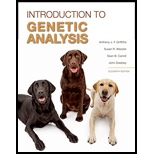
Concept explainers
a.
To determine: The maximum amount of mutation that can be seen in the male chromosomes.
Introduction: The two types of sexes, males and females possess different sexual characteristics due to the presence of their sexual hormones along with the different sex chromosomes. The male shows heterogamety, whereas the female shows homogametic nature.
b.
To determine: The least number of mutations on which chromosome.
Introduction: The cells that are to be inherited undergo the process of meiosis in which there occurs the reduction of chromosome number to half.
c.
To determine: The new mutation rate per base pair on the X and Y chromosome.
Introduction: The male possesses the heterogametic nature, whereas the females possess the homogametic nature. Males have X and Y chromosomes, whereas females have a pair of X chromosomes.
Want to see the full answer?
Check out a sample textbook solution
- Global climate change is expected to result in drastic changes in precipitation patterns. This might mean that, due to the rain shadow effect, the windward sides of mountains might be wetter, while the leeward sides of mountains might be drier. Using what you know about plant taxonomy and ecological relationships, propose a justified, ecological hypothesis on how plant community composition would change on each side of the mountain. Your answer should contain two parts: The hypothesis and the ecological justification addressing the bold points above.arrow_forwardExplain why homologies are used in constructing phylogenetic trees (2 pts). Give two specific examples of how using analogous characters would result in a tree depicting incorrect evolutionary relationships (4 pts). Aarrow_forwardD B - E C - A - Farrow_forward
- Discuss briefly the research on the effects of marijuana smoking on the functioning of the immune system.arrow_forward1) Describe how you would test the hypothesis that lobe eyes are a dominant lethal gene. Run the experiment and see if your hypothesis is correct. b) What are the possible body colors in fruit flies? Place an asterisk next to the wild type body color. c) Draw a fly with star-shaped eyes next to one with lobe eyes and insert your drawing below.arrow_forwardUtilizing the following pedigree, and the key for phenotypes, to the right of it, determine the genotypes of the individuals in the pedigree for blood type inheritance. Individual Blood Type I1 I2 II1 II2 II3 II4 III1 III2 III3 III4 III5 III6arrow_forward
- a)At what wavelength (nm) on a spectrometer can this color be quantified? b) Record your results. Indicate on this page which boxes turned color. A B C + - 1:2 1:10 1:100 c) Based on these results, which patient(s) definitely have lupus, which definitely do not, and which require further testing?arrow_forwarda) Which dog breed has the ancestral allele for all three genes, similar to gray wolves? b)Which dog breeds have a more recent allele for FGF5 but an ancestral allele for KRT71? c)Which coat type is the ancestral allele of the KRT71 gene associated with? d)How might understanding the functions of genes in dogs help us better understand human health?arrow_forwardIf a girl has ptosis and then she marries a man who is a normal eyes, what will be the phenotypic and genotypic ratio of their offspring? 2) Create a small pedigree, noting sex of each individual as well as whether or not they are affected with ptosisarrow_forward
- a) Which types of SNPs might be identified in a GWAS? b)Give two possible reasons for why a SNP would be associated with a trait like fur color. c)Which SNP in Table 1 do you think is completely associated with fur color? Explain the reasoning for your choice.arrow_forwarda) Which SNPs in Table 1 do you think are completely unassociated with fur color? Explain the reasoning for your choices. (Hint: There are five in total.) b) Which SNP in Table 1 do you think has the next strongest association with fur color, after the completely associated SNP you identified two questions ago? Explain the reasoning for your choice. c) Describe a specific problem or question that you could investigate by doing a GWAS with the organism you want to discussarrow_forwarda) What has happened in Bernalillo County to the number of cases of COVID-19 since 01.01.21? b) What is the basis of a traditional vaccine compared to the two top most common SARS-CoV-2 vaccines? c) What is a good resource to use when determining current risks and trends in COVID-19 numbers?arrow_forward
 Human Anatomy & Physiology (11th Edition)BiologyISBN:9780134580999Author:Elaine N. Marieb, Katja N. HoehnPublisher:PEARSON
Human Anatomy & Physiology (11th Edition)BiologyISBN:9780134580999Author:Elaine N. Marieb, Katja N. HoehnPublisher:PEARSON Biology 2eBiologyISBN:9781947172517Author:Matthew Douglas, Jung Choi, Mary Ann ClarkPublisher:OpenStax
Biology 2eBiologyISBN:9781947172517Author:Matthew Douglas, Jung Choi, Mary Ann ClarkPublisher:OpenStax Anatomy & PhysiologyBiologyISBN:9781259398629Author:McKinley, Michael P., O'loughlin, Valerie Dean, Bidle, Theresa StouterPublisher:Mcgraw Hill Education,
Anatomy & PhysiologyBiologyISBN:9781259398629Author:McKinley, Michael P., O'loughlin, Valerie Dean, Bidle, Theresa StouterPublisher:Mcgraw Hill Education, Molecular Biology of the Cell (Sixth Edition)BiologyISBN:9780815344322Author:Bruce Alberts, Alexander D. Johnson, Julian Lewis, David Morgan, Martin Raff, Keith Roberts, Peter WalterPublisher:W. W. Norton & Company
Molecular Biology of the Cell (Sixth Edition)BiologyISBN:9780815344322Author:Bruce Alberts, Alexander D. Johnson, Julian Lewis, David Morgan, Martin Raff, Keith Roberts, Peter WalterPublisher:W. W. Norton & Company Laboratory Manual For Human Anatomy & PhysiologyBiologyISBN:9781260159363Author:Martin, Terry R., Prentice-craver, CynthiaPublisher:McGraw-Hill Publishing Co.
Laboratory Manual For Human Anatomy & PhysiologyBiologyISBN:9781260159363Author:Martin, Terry R., Prentice-craver, CynthiaPublisher:McGraw-Hill Publishing Co. Inquiry Into Life (16th Edition)BiologyISBN:9781260231700Author:Sylvia S. Mader, Michael WindelspechtPublisher:McGraw Hill Education
Inquiry Into Life (16th Edition)BiologyISBN:9781260231700Author:Sylvia S. Mader, Michael WindelspechtPublisher:McGraw Hill Education





